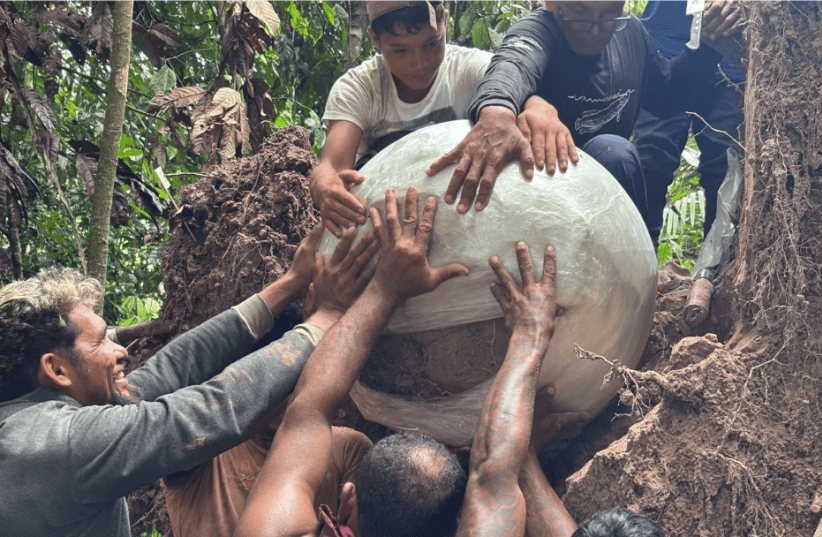
Fishermen from the community of Arumanduba, located in the Médio Solimões region of the state of Amazonas, Brazil, made a discovery. After a 15-meter Paricarana tree fell, they noticed seven giant pre-Columbian funerary urns made of ceramic hidden under its roots. This unexpected find led to an archaeological investigation by researchers from the Mamirauá Institute for Sustainable Development.
An archaeological team from the Mamirauá Institute, in partnership with residents of the São Lázaro do Arumandubinha community, excavated the site and uncovered ancient pottery beneath the fallen tree. Inside the urns, researchers discovered human bones, as well as remains of fish, turtles, and frogs, indicating that the burials were associated with food practices and rituals. "These artificial islands are a form of indigenous engineering conceived to stabilize the land and adapt it to the seasonal conditions of the region," explained Márcio Amaral, an archaeologist at the Mamirauá Institute. According to IFLScience These structures, called landfills and excavations, were created by local indigenous peoples to protect communities from river floods.
The burial site is rare and features urns with characteristics previously unknown in the region, such as their large size and absence of lids. Preliminary analyses revealed that the urns were made using different ceramic techniques and a little-studied composition, including a mixture of clay and non-plastic additives composed mainly of a freshwater sponge called cauxi and caraipé—the ash of tree bark. "We also found fragments with applied layers of clay on the exterior and painted red bands, though it is not yet possible to link these to any known ceramic styles," said archaeologist Geórgea Layla Holanda, who co-led the excavation. Live Science .
The largest urn measures 90 centimeters wide and 55 centimeters high, and with its interior filled with sediments, it is estimated to weigh around 340 kilos. To extract the urns, the community actively participated in the excavation process, building an elevated structure of wood and vines to access them due to challenging terrain conditions. The transfer of the urns to the Mamirauá Institute involved extensive navigation in canoes over a distance of 190 kilometers, taking between 10 and 12 hours depending on the river's flow. To protect the urns during transport, layers of plastic film, plaster bandages, bubble wrap, and wooden supports were used, ensuring they arrived in good condition.
At the Mamirauá Institute's laboratory in Tefé, the urns are undergoing further analysis to learn more about the ancient cultures that once inhabited this corner of the Amazon. Preliminary analyses showed that the urns were made with greenish clay, which is uncommon in the region, and they feature slip and red decorative bands. "These characteristics do not match any known Amazonian ceramic tradition, such as the widely studied Amazonian Polychrome Tradition, which suggests a possible undocumented cultural lineage in the upper Solimões River basin," the researchers clarified.
The age of the urns is currently unknown; however, the team estimates they could be between 200 and 3,000 years old. "Now that the excavation is done, the researchers plan to date the urns, with narrowing the time range being one of their main challenges for the future," reported Live Science. The discovery suggests the existence of a previously unknown multicultural society, contributing to the understanding of pre-Hispanic ceramic traditions in the region.
The area where the urns were found is part of a series of artificial islands constructed by native communities centuries or perhaps millennia ago. These islands were built as protection against seasonal floods, demonstrating indigenous engineering techniques and land management by ancient populations. "These people chose to live permanently in the floodplain and they succeeded: they developed technologies and construction engineering to achieve it," Amaral told El Nacional.
Collaboration with the local population was crucial for the success of the excavation. Community members provided valuable knowledge about the environment and assisted in the challenging excavation process. "This research is more than archaeology: it is about building knowledge through respectful collaboration with traditional communities," Amaral stated. Holanda added, "These are the silenced stories, the hidden truths. It gives indigenous peoples the prominence they deserve: those who truly built the Amazon and who were already here in Brazil long before the invasion," according to El Nacional.
Assisted by a news-analysis system.







0 komentar:
Posting Komentar